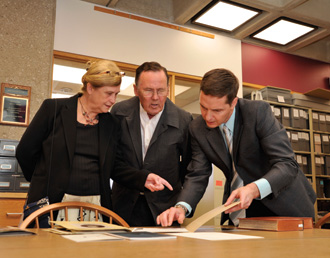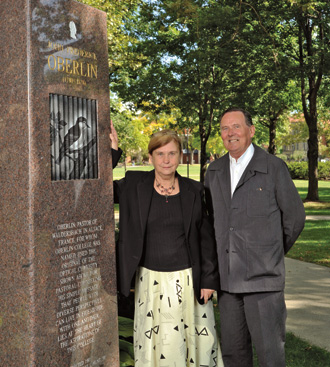Oberlin Alumni Magazine
Fall 2009 Vol. 105 No. 1
Oberlin, Meet Oberlin
 Oberlin College archivist Ken Grossi (right) shows archive items about John Frederick Oberlin to his descendant Anne Roser Perru and her husband, Didier.(photo by Kevin Reeves)
Oberlin College archivist Ken Grossi (right) shows archive items about John Frederick Oberlin to his descendant Anne Roser Perru and her husband, Didier.(photo by Kevin Reeves)
 The Perrus at the campus monument that pays tribute to Oberlin’s namesake, an Alsatian pastor.(photo by Kevin Reeves)
The Perrus at the campus monument that pays tribute to Oberlin’s namesake, an Alsatian pastor.(photo by Kevin Reeves)
A visit from one of John Frederick Oberlin’s descendants brings Oberlin closer to its namesake
At the time of his death in 1826, John Frederick Oberlin had enjoyed fame unique in his era. In a world where communication between countries could take months, the life and work of the dedicated Alsatian pastor were renowned throughout Europe and beginning to make waves in America.
Anne Roser Perru of Paris, France, sent an e-mail message to Oberlin in summer 2009. She identified herself as a seventh-generation descendant of John Frederick Oberlin, one of about 40 direct descendants living in Europe. She and her husband, Didier, were planning a trip to the United States, primarily to visit the college named for her ancestor.
So who was this man in whose honor we are named? In his summer 1990 Oberlin Alumni Magazine article, "Johann Friedrich Oberlin, a Worthy Eponym," former college president S. Frederick Starr described just how well known J.F. Oberlin was (see Notes and Readings for an explanation of the various spellings of the name). "He was admired by Goethe, Schiller, and Tsar Alexander I. Two towns in the United States wanted him to come to this country as a missionary. In Middlemarch George Elliot refers, as if everyone knows what it is, to ‘the spirit of Oberlin.’"
Despite his renown, Oberlin chose to spend his 59-year career serving the people of one of France’s poorest and least educated communities, the Ban de la Roche, an isolated community of five villages high in the Vosges mountains of Northeastern France.
Perru says she was raised to take an interest in her family’s history. She knew of Oberlin’s visionary work and his reputation on her side of the pond when, several years ago, she and her husband encountered a young man sporting a T-shirt emblazoned with the name "Oberlin" at an outdoor farmer’s market in southwestern France. They approached him and learned for the first time of the college in the United States that bears her family’s name. They began planning a visit to John Frederick’s namesake and, as she wrote in an e-mail message, to learn more about "how the relationship was established and continued between Jean-Frédéric Oberlin and the then-young United States."
"[Oberlin] was a contemporary of Jean-Jacques Rousseau, [education theorist] Johann Heinrich Pestalozzi, and Thomas Jefferson. He created the first preschools, even before Pestalozzi and Robert Owen. He helped his own impoverished village to develop through soil enrichment,construction of roads, creation of workshops, employment for women, and financial loans."
Anne Roser Perru, seventh-generation descendant of John Frederick Oberlin
Once the Perrus made contact with the Office of the President, Oberlin staff members began organizing for their daylong September 16 visit. When college archivist Ken Grossi and his staff reviewed Oberlin-related items in the collection, their initial intention to pull a few items for viewing evolved into an exhibit that was on view in the special collections room in Mudd this fall and will eventually be remounted on the Archives’ website (see Notes and Readings for the url). Among the items included are a copy of the first comprehensive English biography of J.F. Oberlin, John Frederic Oberlin (Westview Press, 1976), by John W. Kurtz, who was professor of German at Oberlin from 1932 to 1973; a commemorative plate; a heart-shaped, folded paper book with paintings of J.F. Oberlin’s grave site; a replica of an original bas-relief plaque at Oberlin’s church in Ban de la Roche; and tools Oberlin made and used in his pastoral work, including a watercolor painting depicting the heavens and a hand-cut, hand-colored map of the Ban de la Roche.
During a luncheon with Oberlin College President Marvin Krislov and members of the faculty and staff, Perru talked about her ancestor’s life and work. "He was a contemporary of Jean-Jacques Rousseau, [education theorist] Johann Heinrich Pestalozzi, and Thomas Jefferson." She talked about the modernity of Oberlin’s thoughts and actions in the realms of education and economic initiatives. "He created the first preschools, even before Pestalozzi and Robert Owen. He helped his own impoverished village to develop through soil enrichment, construction of roads, creation of workshops, employment for women, and financial loans," using a system not unlike contemporary microlending.
Perru was delighted to find evidence that the relationship between Oberlin the man and Oberlin the college has continued in our contemporary commitment to access, academic and artistic excellence, and social justice. "I am both pleased and proud to be here today with my husband at Oberlin College, in this magnificent, deeply moving place," she said.
Upon their departure, the Perrus took a woodblock print of J.F. Oberlin’s silhouette, made by Paul Arnold, emeritus professor of art; a copy of John Kurtz’s biography of J.F. Oberlin; and a renewed commitment to maintain the connection between Oberlin’s vision, his descendants, and his namesake.
Cindy Nickoloff is editor of internal communications and a former editor of Oberlin Alumni Magazine.
Go Cardinal Red and Mikado Yellow!
Notes and Readings
J.F. Oberlin’s fame and the Ban de la Roche’s proximity to both France and Germany have resulted in four spellings of his name—Jean-Frédéric (French), Johann Friedrich (German), and John Frederick or John Frederic (English).
Ever wonder where Oberlin’s school colors came from? In 1889, a faculty committee chose them—originally cardinal red and mikado yellow—from the family coat of arms of John Frederick Oberlin. Over the years, they evolved into today’s familiar crimson and gold.
The Oberlin College Archives website has several on-line exhibits and lots of information about Oberlin’s history, and will eventually house the J.F. Oberlin exhibit mentioned in the story:
For more information about J.F. Oberlin, read then-Professor of German John W. Kurtz’s opening assembly address from September 1972, reprinted in the November/December 1972 issue of OAM, titled "What’s in a Name: Why Oberlin?" on the archives site:
www.oberlin.edu/archive/resources/oberlin/why_oberlin.html
Also check out Oberlin’s digital collections:
http://dcollections.oberlin.edu
Oberlin Office of Communications fellow Aries Indenbaum ’09, writer, history geek, circus performer, and former admissions tour guide extraordinaire, gave the Perrus a tour of campus. Read her impressions on her blog, along with a creative reimagining of how Oberlin’s founders picked this particular spot in Ohio to build their college (warning: it involves a bear):
http://blogs.oberlin.edu/about/history_mission/history_tour.shtml
